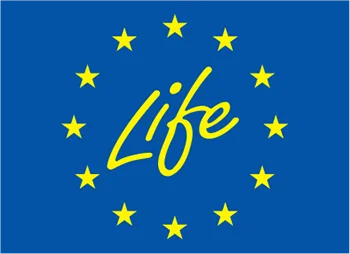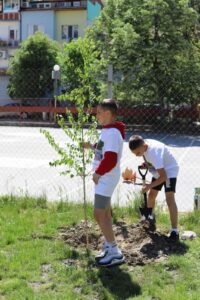On May 13, classes on forest pedagogy and working with children were held in the town of Sandanski with the climate caravan “Forest in a cart”. The event was attended by the forestry educators from the SWSFE Eng. Daniela Belemezova and Eng. Branimira Evtimova, Eng. Michaela Nikolova – Forestry Executive Agency- Blagoevgrad and Eng. Ivan Rizov – Director of Katuntsi Forestry. More than 200 children took part, and the goal of SWSFE and climate caravan “Forest in a cart” is to stimulate public interest and that of adolescents in environmental problems.
On May 19, climate caravan “Forest in a cart” also visited the children of the 5th “b” grade from the Fifth Secondary School “Georgi Izmerliev” in Blagoevgrad, for whom games and activities were also prepared, aimed at educating them in love and care for the forest. Children accepted the challenge to learn about forestry games because they are fun and bring new knowledge about the secrets of animals, plants and trees in the forest.
At the moment, SWSFE implements the following projects financed under the LIFE program:
“Enhancing the restoration, climate resilience and biodiversity value of priority forest habitats within Natura 2000” – LIFE REFOREST. The implementation period is from 02.09.2020 to 31.12.2024.
“Eradication of invasive alien species, recreation and conservation of priority forest habitats within the Natura 2000 network in Northeastern Bulgaria”- LIFE IASHAB with implementation period is from 09.01.2020 – 12.31.2024.
“Climate-Smart Forest Management for Central and Eastern Europe”- LIFE 19 CCA/ SK 001276 -CLIMAFORCEELIFE, with implementation period from 09.2020 until 12.2027.
The key role of the Natura 2000 ecological network of protected areas for the protection of biodiversity in the European Union over the last 30 years is indisputable. The LIFE program, the instrumental companion of the Network, both for its creation and for its management, is the main partner of the SWSFE in carrying out activities on the creation and restoration of forests in Natura 2000 areas. The main facts and figures of the achievements of the Network and the LIFE Program speak for themselves – not only in terms of their contribution to nature conservation – but also of the socio-economic benefits they bring. This year’s Natura 2000 Day also gives us an opportunity to remember the EU’s most important biodiversity targets by 2030 to expand the network of protected areas to 30% of the EU’s land and seas and to step up restoration efforts.
The forest territories in the SWSFE are of key importance for the protection of wildlife. More than 50% of the territory of the SWSFE falls into protected areas of the European ecological network Natura 2000 – 43 areas under the Habitats Directive with a total area of 619,299 ha and 25 areas under the Birds Directive with a total area of 392,585 ha. By order of the Minister of Agriculture and Food, 3% of the state forests falling into protected areas of “Natura 2000” are defined as “forests in the old phase” (total area 20,743 ha). Most often, these are hard-to-reach forests in watersheds or protected areas. In 2018, in connection with FSC forest certification, the share of state forests designated for the protection of old-growth forests and representative samples of natural forest ecosystems reached 71,544 ha (10.4%). About 8% of them are protected areas, with the largest area being the three natural parks “Vitosha”, “Rila Monastery” and “Belasitsa” (65,709 ha in total). There are 88 protected areas (total 7140 ha), and 54 natural attractions (total 2243 ha). The company’s forest territories also border the three national parks managed by the Ministry of Education and Culture – “Rila”, “Pirin” and “Central Balkan”, as well as 41 reserves. In the focus of the professional concerns of forest and hunting are not only economic activities, but also the protection of biological diversity. Forestry activities are limited during the breeding season of rare bird species, such as woodpeckers and owls, as well as in the habitats of rare plant species and peripheral areas around dens of large predators and nests of birds of prey.




